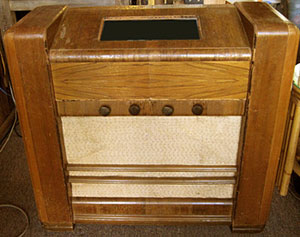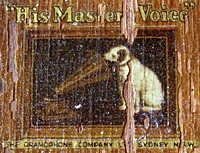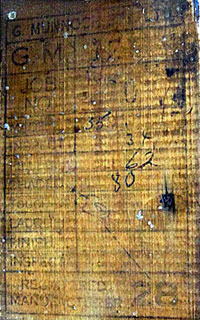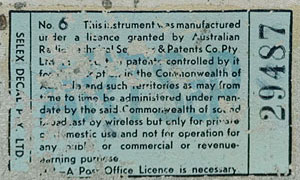
For a long time, I had been thinking about the ideal form for the main unit - some kind of convenient central unit which would fit under the main screen, but tall enough to enable easy operation when standing in front of it.

I thought back to the old radio cabinets they made in the late 40's/early 50's. Some of these were free standing units. Typically, they had a flat dial on a top sloping panel, a few simple controls at the front and a large speaker at the bottom. In particular, I thought of a specific Australian made HMV radio. I remember having to work on one of these once and being impressed by how well it performed. It was an AM and short wave receiver with two speakers, one large and one small, for a wider frequency response. As was typical of such units, the cabinet was "open back" but it still produced reasonably good bass.
The thought of putting a state of art system into an art-deco cabinet like this appealed to me! On the other hand, I thought it would be nice to retain the simplicity of design and resist the temptation to cover the thing in controls.
Imagine my surprise when I walked into an antique store one day half way between Sydney and Tamworth and stumbled across this exact HMV cabinet! This particular unit was a 6V car battery operated version - Model No. 328, built in 1941 by the Gramophone Company in Sydney. It had so-called "battery valves" - special ones with low power filaments and a vibrator unit (a kind of mechanical switched mode power supply) to supply the high voltages for the valves. Interestingly, HMV products manufactured in the 1940's were fitted with an "FM Adaptor" socket, since there was talk as far back as then about introducing FM in Australia!
I'm guessing this came from a remote rural property, with no power. It was purchased during the Second World War, probably one of the few means they had of receiving news. They may have used the short wave function to receive world news.

The cabinet was 820mm (W) x 720mm (H) x 300mm (D) - perfect for my requirements.
The thing was trashed. The speaker cones were torn and some of the valves missing. I considered the chances of finding replacements like 1K7s very slim. The dial glass was broken, with a large piece missing. In a way, this was good news for me - if it had been in better condition, I would have felt obliged to restore it! It seemed like it was meant to be! $80.00 later, I was on my way home with the thing in my boot. Hence, this project was born! I decided to call it the HMV Model 328A, in respectful rememberance of the original 1941 creation.


